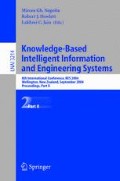Abstract
Ensembles of classifiers have the ability to boost classification accuracy comparing to single classifiers and are a commonly used method in the field of machine learning. However in some cases ensemble construction algorithms do not improve the classification accuracy. Mostly ensembles are constructed using specific machine learning method or a combination of methods, the drawback being that the combination of methods or selection of the appropriate method for a specific problem must be made by the user. To overcome this problem we invented a novel approach where ensemble of classifiers is constructed by a self-organizing system applying cellular automata (CA). First results are promising and show that in the iterative process of combining the classifiers in the CA, a combination of methods can occur, that leads to superior accuracy.
Access this chapter
Tax calculation will be finalised at checkout
Purchases are for personal use only
Preview
Unable to display preview. Download preview PDF.
References
Coello, C.A.C.: Self-Adaptive Penalties for GA-based Optimization. 1999 Congress on Evolutionary Computation, Washington D.C. IEEE Service Center 1, 573–580 (1999)
Dietterich, T.G.: Ensemble Methods in Machine Learning. In: Kittler, J., Roli, F. (eds.) First International Workshop on Multiple Classifier Systems. Lecture Notes in Computer Science (2000), pp. 1–15. Springer, New York (2000)
Flocchini, P., Geurts, F., Santoro, N.: Compositional experimental analysis of cellular automata: Attraction properties and logic disjunction. Technical Report TR-96-31, School of Computer Science, Carleton University (1996)
Freund, Y., Schapire, R.E.: Experiments with a new boosting algorithm. In: Proceedings Thirteenth International Conference on Machine Learning, pp. 148–156. Morgan Kaufman, San Francisco (1996)
Lenič, M., Kokol, P.: Combining classifiers with multimethod approach. In: Proceedings Second international conference on Hybrid Intelligent Systems, Santiago de Chile, December 1-4, pp. 374–383. IOS Press, Amsterdam (2002)
Kirkpatrick, S., Vecchi M. Jr., C.G.: Optimization by simulated annealing. Science, p. 220 (1983)
Towel, G., Shavlik, J.: The Extraction of Refined Rules From Knowledge Based Neural Networks. Machine Learning 131, 71–101 (1993)
Zorman, M., Podgorelec, V., Kokol, P., Peterson, M., Sprogar, M., Ojstersek, M.: Finding the right decision tree’s induction strategy for a hard real world problem. International Journal of Medical Informatics 63, Issues 1–2, 109–121 (2001)
Author information
Authors and Affiliations
Editor information
Editors and Affiliations
Rights and permissions
Copyright information
© 2004 Springer-Verlag Berlin Heidelberg
About this paper
Cite this paper
Povalej, P., Lenič, M., Štiglic, G., Welzer, T., Kokol, P. (2004). Improving Classification Accuracy Using Cellular Automata. In: Negoita, M.G., Howlett, R.J., Jain, L.C. (eds) Knowledge-Based Intelligent Information and Engineering Systems. KES 2004. Lecture Notes in Computer Science(), vol 3214. Springer, Berlin, Heidelberg. https://doi.org/10.1007/978-3-540-30133-2_136
Download citation
DOI: https://doi.org/10.1007/978-3-540-30133-2_136
Publisher Name: Springer, Berlin, Heidelberg
Print ISBN: 978-3-540-23206-3
Online ISBN: 978-3-540-30133-2
eBook Packages: Springer Book Archive

